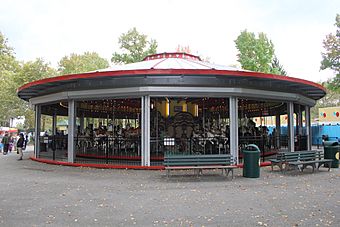Flushing Meadows Carousel facts for kids
Quick facts for kids |
|
|
1964-1965 New York World's Fair Carousel
|
|

Carousel in 2014
|
|
| Location | Flushing, Queens, New York |
|---|---|
| Built | 1964–1965 |
| Architect | William Mangels, Marcus Illions |
| NRHP reference No. | 16000038 |
| Added to NRHP | February 23, 2016 |
The Flushing Meadows Carousel is a fun carousel ride located in Flushing Meadows-Corona Park in Queens, New York City. It has many cool figures, including 64 jumping horses, 7 standing horses, a lion, and 2 chariots. This carousel was made especially for the 1964 New York World's Fair.
It was created by combining parts from two older carousels. Both of these older carousels were carved in Coney Island in the early 1900s. A famous carver named Marcus Illions made many of these figures. The carousel first stood near its current spot during the World's Fair. In 1968, it moved to where it is now and has been giving rides ever since! In 2016, it was added to the National Register of Historic Places, which means it's a very important historical site.
Contents
History of the Carousel Horses
The Flushing Meadows Carousel was built using pieces from two older carousels. These were the Feltman's Carousel from 1903 and the Stubbman Carousel from 1908. Both of these famous rides were originally made for amusement parks in Coney Island.
Coney Island Carousels
Coney Island was a very popular amusement area, especially in the early 1900s. It had more than twenty carousels spinning at one time! The Feltman's Carousel was known as a masterpiece by its carver. It had 24 horses that are now part of the Flushing Meadows Carousel.
The Stubbman Carousel was also very popular. It had 47 horses and its main structure, called the frame, are now part of the Flushing Meadows Carousel. This carousel had fancy chariots that looked like they belonged to royalty.
The Master Carver: Marcus Illions
Both the Feltman's and Stubbman carousels were carved by a master artist named Marcus Illions. He was one of the best carvers in the "Coney Island style." This style was known for its dramatic and fancy designs. The carvers focused on making fantasy creatures, not just realistic ones.
Illions' horses were often very ornate and detailed. The Feltman Carousel was seen as one of his greatest works. The Stubbman horses were a bit simpler but still very beautiful. The main structures for both carousels were made by William F. Mangels, another famous Coney Island ride maker. The Stubbman carousel's frame is the one used for the Flushing Meadows Carousel today. It even has a special feature: slots in the floor that make the horses tilt outwards as the carousel spins faster!
Why the Carousels Moved
The Feltman's Carousel operated for many years, from 1903 to 1963. It was eventually sold because the owners wanted to build a new amusement park ride called the Astrotower. The carousel took up too much space and wasn't making enough money. So, it was carefully packed up.
The Carousel at the World's Fair
A company was formed to bring a carousel to the 1964 New York World's Fair. They decided to buy both the Feltman's and Stubbman's carousels. The Feltman's carousel was in rough shape, so they couldn't just use it as it was. Instead, they bought the Stubbman carousel mainly for its strong frame and mechanical parts.
Since both frames were made by the same company, it was easy to put the beautiful horses from Feltman's onto the Stubbman frame. This created the new carousel for the World's Fair. It opened in July 1964 and offered rides for 15 cents! It was located in a special "Carousel Park" area, designed to feel like a boardwalk.
A Permanent Home
After the World's Fair ended, a very important park official named Robert Moses wanted the carousel to stay in Flushing Meadows-Corona Park forever. So, three years later, the carousel was moved to its current spot. It's now right next to the zoo in the park.
In 2012, a new company took over running the carousel. They made some nice updates, like repainting it and fixing the wooden floor. They also added a fun new train ride called the Choo Choo for families to enjoy!
Images for kids








